My first qvevri wine made in Maryland is not what I expected; however, it definitely was worth the wait. Besides the color, the wine is great. I did not expect the light yellow color. After all, maceration on the skins for six months should have added some color to the Muscat wine. There was little if any color extraction.
The wine did have its merits. The intense orange aroma and taste of the Muscat was readily available. The velvety mouthfeel was surprising and there was a touch of heat on the finish. There was a long orange aftertaste lasting a few minutes. Otherwise, the wine showcased the Muscat grape perfectly.
I brought the 23 liter qvevri from the country Georgia in 2014. After coating the inside with beeswax to seal the pours, I coated the outside with a lime based mortar. The qvevri was then buried underground. I was in Catalonia, Spain on a winery tour during the critical time to purchase grapes. It wasn’t until the middle of October that I was able to get grapes from a supplier. They looked like the leftovers. Kathy and I sorted and destined the grapes by hand. We chose only the best ones for the qvevri. Fermentation was active by October 18th. For the remainder of October, I punched down the grapes. The qvevri was sealed in November and covered with sand. Throughout the winter months the wine aged with the skins, seeds and lees.
Opening the qvevri in the middle of April, I discovered that the sediment did not settle at the qvevri’s bottom. Instead the wine seemed to be in a constant vortex. I racked the wine into a carboy where the particles did settle. It was bottled in late June.
You learn from the past. This year I hope to acquire grapes by early September and crush the grapes prior to putting them into the qvevri. I also plan to add stems this time, omitting them last autumn. I have not decided on the variety, I will have to see what is available.
One of my major concerns last year was oxidation. The wine is not oxidised. I did burn some sulphur over the wine in the qvevri before sealing it last November. This ancient winemaking method worked well. If one wants to truly make a natural wine that lets the grape express itself, qvevri winemaking is the way to go.
Cheers,
Terry




Leave a Reply